Catching up with the Baroque and Before: Part I
By Brian Wilson
The arrival of five CDs of Monteverdi, Vivaldi and Telemann for review
serves to remind me what a wide variety of music is covered by the generic
term ‘baroque’, and also that I have a great deal of catching up to do.
Pandemic and lockdowns notwithstanding, the recording companies have not
left lovers of the music of the baroque and renaissance periods in the
lurch. I’m delighted that we have recently recruited several new reviewers
working from downloads, but monitoring them, editing and converting their
output to html has contributed to my being less productive in my own right.
The best way to make amends is to concentrate principally on those three
composers, so no Bach or Handel, except incidentally, but I plan to return
later for at least one more catching-up article.
Index
GRAUN, TELEMANN, BACH
Passion Pasticcio, c.1750 – Glossa
HILDEGARD, PÉROTIN
, etc – Fuga Libera
ISAAC
Missa Wohlauff gut Gsell
– Hyperion
MONTEVERDI
Il Delirio della Passione
– Pentatone
- Lagrime d’Amante: Madrigals of Love and Grief – Glossa
- Madrigals Book VIII – Naïve
- L’Orfeo – BIS
TELEMANN
Cantatas and Gamba Fantasias – CPO
- Easter Cantatas - CPO
- Gamba concertos and sonatas – Arcana
- Overture Suites – Hungaroton
- Polonoise – Pentatone
- Violin fantasias – Pan Classics
VIVALDI
Bassoon Concertos – Naïve, Pentatone
- Concerti particolari – Passacaille
- Concertos (bassoon, cello, lute) and vocal works – Alpha
- Concertos and sinfonias - Hungaroton
- Flute concertos – Arcana
- Four Seasons and other music arr. recorder – Pentatone
- Violin Concertos IX: Le nuove vie – Naïve
- Violin Concertos (I Musici) – Pentatone
Prologue
(Baroque Operas) – Pentatone
Tiranno: Music about Nero by MONTEVERDI, A. SCARLATTI and HANDEL
***
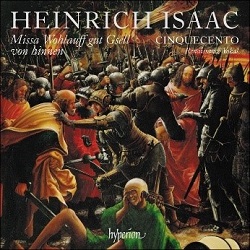 Heinrich ISAAC (c.1450-1517)
Heinrich ISAAC (c.1450-1517)
Missa Wohlauff gut Gsell von hinnen
(6vv) [41:42]
Josquin DESPRES (1450/55-1520)
Comment peult avoir joye?
[2:14]
Heinrich ISAAC
Recordare, Jesu Christe
[4:45]
Quis dabit pacem populo timenti?
[5:57]
O decus Ecclesiæ
[12:13]
Judæa et Jerusalem
[6:48]
Cinquecento Renaissance Vokal
rec. 6-8 January 2020, Kartause Auerbach, Vienna. DDD.
Texts and translations included
Reviewed as downloaded from
hyperion-records.co.uk
HYPERION CDA68337
[78:03]
CD from
Amazon UK –
Presto
I couldn’t resist beginning this survey before the time span of the
baroque. If there’s one period of music that I turn to even more, it’s the
renaissance – strictly, the only period where I have any qualification, a
Master’s degree in the arts and literature of that period from long ago.
There’s no contest here: not only the main work, Isaac’s Mass on the
secular tune Wohlauff gut Gsell (roughly, ‘let’s get up and going,
mate’), but several of the shorter pieces, are not otherwise available.
Even the Josquin, the original tune which forms the basis of the Mass, is
an only recording, though he’s hardly a neglected composer, especially now
that The Tallis Scholars have completed their series of his Masses for
Gimell –
review.
The only serious competition comes in a Glossa recording of Isaac’s Missa Misericordias Domini and Motets (GCDP31908). That recording
by Cantica Symphonia and Giuseppe Maletto includes O decus Ecclesiæ. While that album is well worth having in its own
right – once again, the main work appears in the only available version –
it’s polished off a little briskly by comparison with the new Hyperion,
which becomes the ideal introduction to Isaac’s music. Not only is the Wohlauff Mass one of his most imposing and sonically splendid
settings, as David J Burn notes in the booklet – itself well up to
Hyperion’s high standards – the shorter works also add to the value of this
very welcome release.
As for the performances, I need add little to the praise of Cinquecento –
see Dominy Clements’
review
of their Palestrina – while the recording, which I downloaded in 24/96
format, is equally first-rate. My
review
of Cinquecento’s Vaet was from inferior mp3 from iTunes; Hyperion’s own
download of that is of much better quality and costs only £7.30, less than iTunes
mp3, even in superior 24-bit format – here.
Lovers of the music of the renaissance should note that Hyperion’s 10-CD
set with The Sixteen in Music of the Golden Age of English Polyphony
is currently on sale for just £15 (CD or download) from
hyperion-records.co.uk.
That was already a splendid bargain when I recommended it at a higher
price (CDS44401 –
review
–
review). It’s irresistible now.
Claudio MONTEVERDI (1567-1643) can in many
respects be regarded as the father of the baroque. That’s
not to forget his fore-runners, the Gabrielis, the composers involved in
the Florentine intermedii, and the two composers who vied to be
first off the blocks with an opera, Peri and Caccini, both on the theme of
Orpheus and Euridice, and both believed to have influenced Monteverdi.
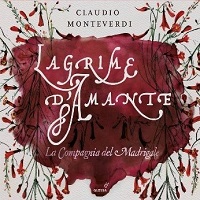 Lagrime d’amante, Madrigals of love and grief, contains a selection from Monteverdi’s madrigals, from Book 1 to Book 6:
Lagrime d’amante, Madrigals of love and grief, contains a selection from Monteverdi’s madrigals, from Book 1 to Book 6:
Ecco mormorar l’onde
2
[3:36]
Era l’anima mia
5
[3:52]
A un giro sol de’ belli occhi lucenti
4
[2:44]
Ecco Silvio, colei
5
[5:57]
Mentr’io mirava fiso
2
[3:12]
Baci soavi e cari
1
[3:15]
Non più guerra, pietate
4
[3:07]
Rimanti in pace
3
[8:15]
O primavera, gioventù del anno
3
[3:11]
Ah, dolente partita
4
[4:07]
Zefiro torna
6
[3:54]
Longe da te, cor mio
4
[3:12]
Lagrime d’amante al sepolcro dell’amata
(Sestina)6 [18:09]
Primo libro dei madrigali, 15871
Secondo libro dei madrigali,
15902
Terzo libro dei madrigali, 15923
Quarto libro dei madrigali, 16034
Quinto libro dei madrigali, 16055
Sesto libro dei madrigali, 16146
La Compagnia del Madrigale:
Rossana Bertini, Francesca Cassinari (soprano)
Elena Carzaniga (alto)
Giuseppe Maletto, Raffaele Giordani (tenor)
Daniele Carnovich, Matteo Bellotto (bass)
rec. Cumiana, Confraternita dei Santi Rocco e Sebastiano, Torino, Italy,
16-21 September 2018 and 5-6 July 2020. DDD.
Texts and translations included.
Reviewed from CD and 24/88.2 streamed version.
GLOSSA GCD922810
[76:34] CD from
Amazon UK
–
Presto:
stream
Naxos Music Library
This selection of Monteverdi madrigals from the first six books is
dedicated to Daniele Carnovic, whose contribution to this 2018 Monteverdi
album was his swan song for La Compagnia del Madrigale. For that alone the
recording is very welcome; his contributions to earlier Monteverdi
recordings from this team were among the highlights. The new collection of
secular music neatly complements their earlier recordings of selections
from the Selva morale e spirituale (Lamento della Madonna, GCD922805:
Recording of the Month
–
Early Summer 2017)
and the 1610 Vespers (GCD22807). Much as I enjoyed the former, I found
myself at odds with another colleague concerning the Vespers – see again
Early Summer 2017.
The new recording brings an interesting selection of the familiar and the
unfamiliar. Apart from complete recordings of Book II, for example, there
are not many other versions of the opening Ecco mormorar l’onde.
The Compagnia make rather more of the pictorial qualities of this music
than even Rinaldo Alessandrini and Concerto Italiano (Book II, Naïve
OP90128, download only), but otherwise there’s little to choose between
them.
Both are preferable to Delitiæ Musicæ in their complete Naxos recording of
Book II, though that is one of their better offerings (8.555308 –
review
–
review). As the Naxos series progressed, they became less competitive for me.
(See my
review
of Book VI.)
Among the more familiar works
on the new Glossa is Zefiro torna from Book VI. Based
on a standard Petrarchan conceit – Spring returns, but brings only more
grief for the tormented lover – Monteverdi made two settings of the
Rinuccini poem. The other setting, from Scherzi musicali, features
on Il Delirio della Passione (below), so the two releases neatly
complement one another in that and other respects: Il Delirio
takes more liberties, but justifies the risk. I’ve mentioned that Delitiæ
Musicæ on Naxos tended to slow down as their series progressed. As it
happens, their version of Zefiro torna is not one of the worst
offenders – at 4:16, it’s only a little slower than on the new Glossa
recording or the older La Venexiana Book VI (also Glossa GCD920926,
download only –
review
of earlier release) – even so, the sweet return of the beautiful season at
the opening is overshadowed by the lament, whereas the two moods are evenly
balanced on the two Glossa recordings.
It’s not that La Compagnia can’t do tragic, as their recording of Il pianto della Madonna, on their earlier recording, and the Lamento d’Amante, the long piece which closes the new recording,
amply prove. The Lamento receives an emotional, but not
over-egged, performance on the new Glossa; on Naxos, the listener ends as
worn out as the protagonist, which I don’t mean as a compliment. At least,
that recording is more worth spending your money on than a Newton Classics 3-CD
reissue of sacred and secular Monteverdi from Angelo Ephrikian –
review.
The new Glossa is very well recorded. The 24/88.2 streamed version to which
I listened adds somewhat to the quality, but, you may feel, not so greatly
as to justify the extra cost.
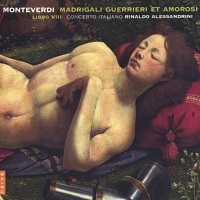 There’s one very clear advantage in Glossa’s concentration on music from
the early books of madrigals: it leaves the field open for a collection of
music from the later books, and I know of no better set to recommend than
that recorded by Rinaldo Alessandrini with Concerto Italiano – Book 6
complete on Arcana A425 or Naïve OP30423 (download only), Book 8 on
OP30435. My only regret is that their recording of Book 8, once a splendid
bargain on 3 CDs for the price of 2, is now an expensive download from some
dealers (around £29 in lossless sound) and comes without the booklet.
Bargain hunters should check it out from Qobuz for a more amenable £6.39
from
Qobuz,
still no booklet, however.
There’s one very clear advantage in Glossa’s concentration on music from
the early books of madrigals: it leaves the field open for a collection of
music from the later books, and I know of no better set to recommend than
that recorded by Rinaldo Alessandrini with Concerto Italiano – Book 6
complete on Arcana A425 or Naïve OP30423 (download only), Book 8 on
OP30435. My only regret is that their recording of Book 8, once a splendid
bargain on 3 CDs for the price of 2, is now an expensive download from some
dealers (around £29 in lossless sound) and comes without the booklet.
Bargain hunters should check it out from Qobuz for a more amenable £6.39
from
Qobuz,
still no booklet, however.
Whatever else, don’t overlook a budget Monteverdi reissue on the Alto label
of Emma Kirkby and Evelyn Tubb, with the Consort of Musicke and Anthony
Rooley: Duets and solos, sacred and secular (ALC1060, around £6).
I’ve mentioned the two Orpheus and Euridice operas of 1600, but the first
important opera, on the same theme, and probably influenced by those
predecessors, came just seven years later from Monteverdi:
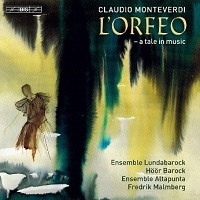 L’Orfeo: Favola in musica (Mantua, 1607)
L’Orfeo: Favola in musica (Mantua, 1607)
Ensemble Lundabarock:
Johan Linderoth – (tenor, Orfeo)
Kristina Hellgren – (soprano, La Musica, Proserpina)
Christine Nonbo Andersen – (soprano, Ninfa 1, Euridice)
Maria Forsström – (mezzo, Messaggiera)
Anna Zander – (mezzo, Pastore 1, Speranza)
Adam Riis – (tenor, Pastore 2, Apollo, Eco)
Daniel Åberg – (baritone, Pastore 3, Spirito infernale 2)
Steffen Bruun – (bass, Caronte)
Karl Peter Eriksson – (baritone, Pastore 4, Plutone)
Ann-Margret Nyberg – (soprano, Ninfa 2)
Rasmus Gravers Nielsen – (tenor, Spirito infernale 1)
Staffan Alveteg – (bass, Spirito infernale 3)
Höör Barock
Ensemble Altapunta/Fredrik Malmberg (organ)
rec. July/August 2019, Eslövs Kyrka, Sweden. DDD/DSD
Reviewed as downloaded in 24/96 sound with pdf booklet from
eclassical.com.
Texts and translations included.
BIS-2519 SACD
[47:19 + 58:20] CD from
Amazon UK
–
ArkivMusic –
Presto:
stream
Naxos Music Library
One of my colleagues is working on a detailed review of this recording, so
my comments are merely first reflections. With recordings of L’Orfeo in all price ranges and to suit all tastes, I must admit
that my initial thought was to wonder where and even if this new BIS
offering would fit in. Well, it does start with one clear advantage, in
that it’s available on SACD and as a 24/96 download in surround sound, as
well as in 16- and 24-bit stereo. If you hurry, 24-bit is on offer from
eclassical.com for the same reasonable price as 16-bit.
I’ve listed two alternative recordings of the opening Prologue below. Il Delirio della Passione, with Anna Lucia Richter, Ensemble
Claudiana and Luca Pianca, opens with either an over-the-top or a
stimulating account of La Musica’s aria from the prologue, Dal mio Permesso, depending on your point of view. I’m not sure
that I always want to hear the music quite as lively as this, especially as
Emma Kirkby’s gentler presentation of the part on the Medlam recording
of the opera is
my ideal (now download only, and without booklet. Be careful to choose
Erato Veritas 4820702, around £11 in lossless sound, rather than Warner’s
alternative which sells for £29!). Richter and Pianca dive straight into
the piece, without the stirring toccata which should precede it; that
introduction, so striking that Monteverdi used it again to open the 1610
Vespers, is there replaced with a tambourine roll. This very lively version
of Music setting the scene, not so much with her accustomed sweet accents – dolci accenti – as inflaming the coldest minds – Posso infiammar le più gelate menti – serves to point the fact
that the new BIS recording, at least at the outset, offers one of the
cooler interpretations. It’s not a matter of tempo – Richter and Pianca
take almost exactly the same time as Kristina Hellgren and Fredrik
Malmberg on the new BIS, but their account certainly fits the Delirio della Passione of the album’s title.
If I say that the new BIS Orfeo is ‘safer’ than that, I don’t mean
to decry it; it joins my list of top choices, but my heart is still with
Emma Kirkby, Nigel Rogers and Charles Medlam; if you choose the correct
download, as listed above, it’s also very inexpensive. If you don’t mind
some broad tempi, there are two even more inexpensive recordings directed
by Sergio Vartolo, on Naxos and Brilliant Classics. I rate his Brilliant
Classics recording of Il Ritorno d’Ulisse very highly (93104);
it’s one of the reasons why I think that opera as fine in its way as L’Orfeo, but you may think the slower tempos less appropriate in
the latter. Now download only in the UK, and on sale from some dealers for
an unrealistic price of over £28, Qobuz offer his Ulisse in
lossless sound for £6.47, albeit shorn of the de-luxe booklet that came
with the CDs. His L’Orfeo is also download only, on offer for a
more realistic £5.42, again without booklet, but libretto and translation
can be downloaded from
Brilliant Classics
(94373 –
review).
Claudio MONTEVERDI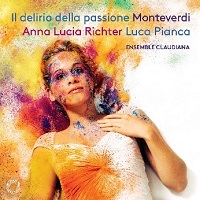 : Il Delirio della Passione
: Il Delirio della Passione
L’Orfeo (1607):
Prologue ‘Dal mio Permesso amato’ [5:44]
Scherzi musicali (1632): Zefiro torna
[6:23]
Quarto scherzo delle ariose vaghezze (1624): La mia turca
[2:18]
Lamento d’Arianna, SV22 (1623)
[12:14]
L’incoronazione di Poppea (1643): Pur ti miro
[3:54]
Scherzi musicali (1632): Et è pur dunque vero
[7:39]
Confitebor tibi domine, SV296 (1641)
[8:33]
Madrigali guerrieri et amorosi [Book 8] (1638): Lamento della Ninfa, SV163 [6:58]
Quarto scherzo delle ariose vaghezze (1624):
Si dolce è il tormento, SV332 [4:30]
Ohimè ch’io cado
[4.03]
Anna Lucia Richter (soprano)
with Dimitri Sinkovsky (countertenor), Teo Aroni (tenor), Ciro Aroni
(tenor), Alessandro Ravasio (bass)
Ensemble Claudiana/Luca Pianca (archlute, theorbo & ceterone)
rec. 2-5 January 2020, Auditorio Stelio Molo, Radiotelevisione svizzera di
lingua italiana, Lugano, Switzerland
Reviewed as downloaded in 24/96 sound from
pentatonemusic.com
PENTATONE PTC5186845
[62:25]
CD from
Amazon UK
–
ArkivMusic –
Presto:
stream
Naxos Music Library
If there is one composer who exemplifies the transition from the polyphony
(prima prattica) of the sixteenth century and the new seconda prattica of the seventeenth, it’s Monteverdi. While it
would be impossible to encapsulate his work in an hour, this new Pentatone
recording gives us a very good cross-section, from opera – his L’Orfeo was the first masterpiece in that form – madrigal and
madrigal-like music, and sacred music. Though the latter category is
represented only by the Confitebor of 1641, that leaves the
listener scope to choose a recording of the great Vespers of 1610 or is
other sacred works. Cue I Fagiolini in 'The other Vespers' –
review.
It’s all beautifully sung by Anna Lucia Richter, repeating her success in
Schubert Lieder – Recommended
review.
And, in case her beautiful and expressive singing is not enough, she’s
very ably supported by other very fine singers in some of the numbers. Very
well supported, too, by Ensemble Claudiana and Luca Pianca, whose
instrumental contributions to Lamento d’Arianna replace the
lost choral sections and make this one of the most recommendable of the
recordings of one of Monteverdi’s most popular works; so popular that he
adapted it as a lament of the Virgin Mary, as beautifully sung by Emma
Kirkby on a budget-price Alto recording of Monteverdi with other
distinguished soloists, the Consort of Musicke and Anthony Rooley
(ALC1160). Regular readers will know how very taken I am with Emma Kirkby,
but Richter comes very, very, close to matching her in this new anthology.
Yes, a few liberties are taken with Monteverdi, enough to make Stuart
Sillitoe write that, though well performed and colourful, it’s not one for
the purist –
review.
As a purist – a pedant, even – I have to say that I was not disturbed.
I’ve mentioned the OTT account of the Orfeo Prologue in my review of the
BIS recording, but I think you may well forgive that for the sake of a very
powerful set of interpretations of Monteverdi’s sacred and secular music. I
was going to say that the duet from Poppea, Pur te miro,
was worth the price of the whole album, but the Lamento d’Arianna
is even better, matching anything that I have heard.
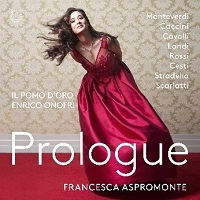 Prologue
Prologue
Claudio MONTEVERDI (1567-1643)
L’Orfeo: Toccata and Prologue Dal mio Permesso amato (La Musica)
(Premiered in Mantova, Palazzo Ducale, 1607)
Giulio CACCINI (1551-1618)
L’Euridice: Prologue Io che d’alti sospir
(La Tragedia) (Premiered in Florence, Palazzo Pitti, 1602)
Francesco CAVALLI (1602-1676)
La Didone: Sinfonia and Prologue Caduta è Troia (Iride) (Premiered in
Venice, Teatro San Cassiano,
L’Eritrea: Prologue Nelle grotte arimaspe (Iride) (Premiered in Venice,
Teatro Sant’Apollinare, 1652)
Stefano LANDI (1587-1639)
Il Sant’Alessio: Sinfonia and Prologue Roma son io (Roma) (Premiered in Rome,
Palazzo Barberini, 1632)
Luigi ROSSI (1597-1653)
Il palazzo incantato overo La guerriera amante: Prologue Vaghi rivi (La Pittura) (Premiered in Rome, Teatro
delle Quattro Fontane, 1642)
Francesco CAVALLI (1602-1676)
L’Ormindo: Sinfonia and Prologue Non mi è Patria l’Olimpo (L’Armonia)
(Premiered in Venice, Teatro San Cassiano, 1644)
Pietro Antonio CESTI (1623-1669)
Il Pomo d’oro, Sinfonia and Prologue Amore et Imeneo (La Gloria Austriaca)
(Premiered in an open-air theatre in Vienna, 1668)
Alessandro STRADELLI (1639-1682)
Sinfonia a due violini e basso
Pietro Antonio CESTI (1623-1669)
L’Argia: Sinfonia e Prologo De’ gotici splendori (Amore) (Premiered in
Innsbruck’s Court Theatre, 1655
Alessandro STRADELLA (1639-1682)
Prologo per musica. La Pace incatenata che dorme, si risveglia e dice:
Con meste luci
(Premiered in Rome, [?] 1668)
Alessandro SCARLATTI (1660-1725)
Gli equivoci in amore, o vero La Rosaura: Sinfonia and Prologue Cessate, oh fulmini! (Venere) (Premiered
in Rome, Palazzo della Cancelleria, 1690)
Francesca Aspromonte (soprano)
Il Pomo d’Oro/Enrico Onofri
rec. Teatro delle Voci, Treviso, 19-22 December 2016. DDD.
Texts and translations included
Reviewed as 24/96 stereo download from
pentatonemusic.com.
PENTATONE PTC5186646 SACD
[74:30]
SACD from
Amazon UK
–
ArkivMusic –
Presto
I’ve departed slightly from my own brief here
again with this recording of the
prologues to several seventeenth-century operas. Every good classical story
requires a prologue, as those old enough to remember Frankie Howard in Up Pompeii will recall, and the same applies to early opera,
usually with a deity or allegorical figure descending to set the scene. As
I wrote back in
Autumn 2018/2,
this rather odd concept works very well; it even left me wanting more.
Why am I returning to it now? I’ve now obtained access to Pentatone hi-res
downloads – this one is available in stereo and surround sound, which is a
good reason to remind readers of its existence.
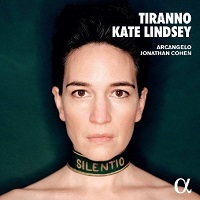 Tiranno
Tiranno
Alessandro SCARLATTI (1660-1725)
Il Nerone
(1698?) [12:38]
George Frideric HANDEL (1685-1759)
Agrippina condotta a morire, HWV110 (c.1707-09) [24:36]
Claudio MONTEVERDI (1567-1643)
L’incoronazione di Poppea
(1643)
Or che Seneca è morto
(II, 5) [6:08]
Son rubin preziosi
(II, 5) [2:13]
Addio Roma!
(III, 6) [4:02]
Pur ti miro! Pur ti godo!
(III, finale) [4:25]
Bartolomeo MONARI (1662-1697)
La Poppea
(1685)* [9:18]
Alessandro
SCARLATTI
La Morte di Nerone
(c.1690s?)* [11:59]
* premiere recordings
Kate Lindsey (mezzo)
With Nardus Williams (soprano) and Andrew Staples (tenor)
Arcangelo/Jonathan Cohen (harpsichord & chamber organ)
rec. 19-21 October 2020, Church of St Jude-on-the-Hill, London. DDD.
Texts and translations included
Reviewed as downloaded from press preview
ALPHA 736
[75:32] CD from
Amazon UK
–
ArkivMusic –
Presto:
stream Naxos Music Library
I’ve broken the rule again by sneaking Handel and Scarlatti in via the back
door in this anthology of music centred on the figure of the Emperor Nero,
the tyrant of the title, but the central tracks are devoted to a selection
from Monteverdi’s Poppea. There’s a very wide range of moods on
this recording, all splendidly encompassed by Kate Lindsey, with a little
help from Nardus Williams and Andrew Staples (one track each) and, more
substantially, from Arcangelo and Jonathan Cohen. There are other very fine
versions of the Handel, but it’s superfluous to list them when there is no
exact analogue of this recital; indeed, the last two items are receiving
their first recordings.
The various works are arranged in roughly chronological order of Nero’s
life, laid out in its outline in the booklet, but the arrangement works
much better than might be imagined. If the Monteverdi and the work of the
young Handel steal the show, the other pieces are well worth hearing in
such fine performances.
Before Monteverdi, most of us had probably discovered Antonio VIVALDI (1678-1741).
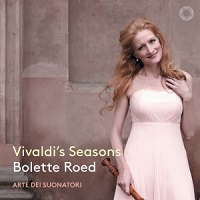 The Seasons
and other concertos arranged for recorder and orchestra:
The Seasons
and other concertos arranged for recorder and orchestra:
Violin Concerto RV257, in E flat [10:34]
Concerto in A, RV335a ‘Il rosignuolo’ [10:53]
Violin Concerto in E, RV271 ‘L’Amoroso’ [9:41]
Concerto in E, Op.8 No.1, RV269 ‘Spring’ (arr. for recorder &
orchestra) [9:42]
Violin Concerto, Op.8 No.9 in d minor, RV236 [8:20]
Violin Concerto, Op.4 No.7 in C, RV185 [8:52]
Violin Concerto, Op.4 No.8 in d minor, RV249 [7:55]
Concerto in g minor, Op.8 No.2, RV315 ‘Summer’ (arr. for recorder &
orchestra) [10:35]
Oboe Concerto in C, RV449 [9:26]
Violin Concerto, Op.4 No.6 in g minor, RV316a [9:37]
Violin Concerto, Op.4 No.4 in a minor, RV357 [8:39]
Concerto in F, Op.8 No.3, RV293 ‘Autumn’ (arr. for recorder &
orchestra) [11:04]
Concerto Op.9 No.3 in g minor RV334 [10:43]
Concerto in b minor for Violin RV389 [11:28]
Violin Concerto, Op.4 No.10 in c minor, RV196 [8:19]
Concerto in f minor, Op.8 No.4, RV297 ‘Winter’ (arr. for recorder &
orchestra) [8:34]
Bolette Roed (recorder)
Arte Dei Suonatori
Reviewed as 24/96 stereo download from
pentatonemusic.com.
PENTATONE PTC5186875
[2 CDs - 2:34:51]
CDs from
Amazon UK
–
ArkivMusic –
Presto:
stream
Naxos Music Library
Of recording many Seasons there is no end, but, contrary to the
rest of the near-quotation from Ecclesiastes, much study of this music is
far from a weariness of the flesh. Every version that I have ever heard
brings something new, even if, as with Nigel Kennedy, it’s something new
that I don’t wish to hear. Pentatone have given us something rather
different: a recording with the recorder replacing the violin (mainly) or
oboe, and, for good
measure, with each of the seasons wrapped in a variety of other Vivaldi
concertos. The
programme is arranged so that each of the first four Op.8 concertos is in a
section with other concertos appropriate to that season. The arrangement
may be subjective, but you do get a lot of Vivaldi for your money.
Does it work, or is the result like Dr Johnson’s typically offensive dictum
on hearing a lady preacher – not well done, but a surprise that it could be
done at all? These arrangements work very well indeed; after all, Vivaldi
himself often specified the violin or oboe as alternative solo instruments, and from
the oboe to another wind instrument is no great distance. The performances
are first-rate, from both Bolette Roed and Arte dei Suonatori; the whole is
very enjoyable, and not just as a novelty one-off.
There’s no SACD, and the download is stereo only, but, in its 24/96 format,
very good.
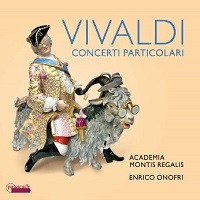 Antonio
VIVALDI
Concerti Particolari:
Antonio
VIVALDI
Concerti Particolari:
Sinfonia for Strings in G, RV149 ‘Il coro delle Muse’ [5:55]
Concerto Conca
for Strings in B-Flat, RV163 [3:22]
Concerto Madrigalesco
for Strings in d minor, RV129 [4:23]
Concerto Alla Rustica
for Strings, two oboes (bassoon) and continuo in G, RV151 [3:45]
Sinfonia Al Santo Sepolcro
for Strings, senza organi ò cembali, in b minor, RV169 [5:36]
Concerto for strings, two violins and cello, No.12, RV159 [4:30]
Concerto for strings No.8, RV127 [4:00]
Concerto for Strings in A, RV158 [7:11]
Concerto for Strings, solo violin and continuo, in g minor, RV155 [9:52]
Concerto (Sinfonia) for Strings in e minor, RV134 [5:30]
Concerto for strings No.5, RV114 [6:20]
Emiliano Rodolfi (oboe), Simone Laghi (viola), Thomas Meraner (oboe),
Alessandro Nasello (bassoon), Paolo Perrone (violin), Alessandro Palmeri
(cello);
Academia Montis Regalis/Enrico Onofri (violin)
rec. Sala Ghislieri, Mondovì (Italy) 28–31 July 2020. DDD.
Period instruments. Pitch 440 Hz, meantone sixth comma.
PASACAILLE PAS1100
[60:42] CD from
Amazon UK
–
ArkivMusic –
Presto
The complexity of couplings makes it difficult to recommend a ‘where next’
for those seeking to expand their knowledge of Vivaldi after the Four
Seasons. The rest of the Op.8 set – a further eight concertos – and the
Op.3 and Op.4 sets would be a good place, but after that there’s a
bewildering choice of concertos. You could cut the Gordian knot and choose
one of the Brilliant Classics box sets, thereby obtaining mostly very decent
recordings and some first-rate ones from L’Arte dell’Arco and Federico
Guglielmo: Complete Concertos and Sonatas (95200, 20 CDs, around £30) or
Complete Works (94840, 66 CDs, around £68 –
review).
If you want to expand your collection more slowly, however, this new
recording of various concertos is likely to tempt those who like their
Vivaldi up-beat. The bizarre cover shot of a man on a goat, both wearing
spectacles, surprisingly not modern, but Meissen ware from the eighteenth
century, gives an idea that these are fast and furious performances. By the
centre of the gatefold, the goat’s pince-nez have fallen off, and on the
rear cover of the booklet so has the man’s hat.
I enjoyed hearing these performances, but, with bulging hairpin dynamics
and fast tempi, they will not be to all tastes, even among my MusicWeb
colleagues, some of whom feel that period performance has thrown the baby
out with the bath water. I must admit that I wanted to listen to something
a little less hectic afterwards – some of the slow movements here could do
with a little more tenderness – but don’t let that put you off.
This team’s earlier outing in Vivaldi, for Naïve (OP30417, now download
only) earned plaudits, not least for the sheer virtuosity of Onofri’s
playing. If anything, that’s even more in evidence on the new recording.
The sound is bright and up-front to match the playing – and, something of a
novelty nowadays, the harpsichord continuo is evident but not too evident.
It comes at full price, and there are less expensive ways to get to know
Vivaldi, not only the Brilliant Classics sets listed above; they also offer
Guglielmo and his team in smaller doses, while L’Archicembalo offer all the
concertos and sinfonias for strings on a 4-CD set (Brilliant 95835 –
review).
There’s also a London Baroque recording of Vivaldi Trio Sonatas, including
RV169 and rV114 (BIS-1025, 2 CDs, or download from
eclassical.com). Recorded in 2000, it was a prelude to their series of C18 trio sonatas,
now available as an 8-CD box set (BIS-9050), download in 16- or 24-bit from
eclassical.com,
and it shares the virtues of those later recordings.
The earlier Vivaldi recording from Onofri and his team was Volume I of
Naïve’s project to record all Vivaldi’s violin concertos. We’re now up to
Volume IX of that series, Volume 67 of their ambitious Vivaldi project, now
two decades along, with another stalwart team of Italian period performers:
Antonio VIVALDI
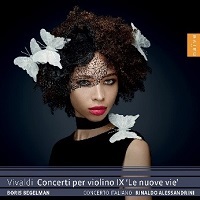 Le nuove vie: Concerti e musica da camera
Le nuove vie: Concerti e musica da camera
Violin Concerto in F, RV283 [13:39]
Violin Concerto in B-flat, RV365 [13:37]
Violin Concerto in C, RV194 [8:35]
Violin Concerto in D, RV211 [14:51]
Violin Concerto in A, RV346 [11:31]
Violin Concerto in e minor, RV281 [11:00]
Boris Begelman (violin)
Concerto Italiano/Rinaldo Alessandrini (harpsichord)
rec. Lonigo, Italy, August 2020. DDD.
NAÏVE OP7258
[73:16] Due for release in some countries on 11 June 2021 and on 2 July
2021 in UK.
Pre-order from
Presto.
The description of this volume as ‘new directions’ is explained in the
booklet as describing the music which Vivaldi composed from 1725 onwards.
You may regard it as a peg on which to hang a fine recording of these
concertos and chamber-scale music, but the proof of the ascription is in the
performances, and these six concertos certainly serve to refute the idea that the Red
Priest’s music all sounds the same.
This is No.IX of the Naive Vivaldi Violin Concertos and it
continues the good work in style. Alessandrini and his Concerto Italiano contributed some of the earlier
recordings in the series, but others have followed with equally fine
sequels, most recently Le Concert de la Loge and Julian Chauvin, a
Recommended recording from 2020 (Il Teatro, OP30805 –
review).
Of my various CD-, SACD- and blu-ray players, one refused to recognise this
CD.
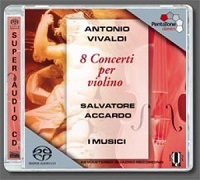 Antonio VIVALDI
Antonio VIVALDI
Violin Concertos Op.7 (1720)
No.2 in C, RV188 [9:14]
No.3 in g minor, RV326 [8:07]
No.4 in a minor, RV354 [9:57]
No.5 in F, RV258a [9:30]
No.6 in B-flat, RV374 [8:11]
No.8 in G, RV299 [7:34]
No.9 in B-flat, RV373 [11:19]
No.10 in F, RV294a [8:47]
Salvatore Accardo (violin)
I Musici
rec. July 1975. ADD.
Reviewed as downloaded in 24/96 quality stereo from
pentatonemusic.com.
PENTATONE PTC5186130 SACD
[72:51]
SACD from
Amazon UK
–
ArkivMusic –
Presto
Also available: complete Op.7 with Heinz Holliger (oboe), Salvatore Accardo
(violin) and I Musici on two Presto special CDs – Philips 4264092.
I’ve included this recording, made originally in quad sound by Philips and
remastered on SACD and as a hi-res download in 2- and 4-channel versions,
partly because it represents the best of the ‘old school’ Vivaldi, as
period-performance techniques were beginning to be taken on board by groups
like I Musici and the Academy of St Martins, partly because recordings of
the Op.7 concertos are rare, and partly as a contrast to the two recent
Vivaldi albums.
It’s only by comparison with the better-known Op.3, Op.4 and especially the
Op.8 sets that Op.7 represents less than the very best. It’s also the case
that the 1720 Dutch publication- and that of Op.6 – may have been a
knock-off. Both need a good deal of editing, but these I Musici
performances serve to remind us that even at less than his peak Vivaldi is
still well worth investigating, especially as in 24-bit sound (two-channel,
I can’t speak for the multi-channel), the Pentatone sounds almost
new-minted.
This single album omits the oboe concertos – for them you need the Presto
CDs, which contain the same performances of the violin concertos, or the
2-CD Brilliant Classics set from L’Arte dell’Arco with Federico Guglielmo
(violin) and Pier Luigi Fabretti (oboe) (95044, 2 CDs or download,
super-budget price –
review,
or complete Op.1 to Op.12, 95200, 20 CDs, around £30).
Heard in their own right, I Musici are well worth having, thanks mainly to
the snappy violin solos and tasteful decoration of Salvatore Accardo. Less
hectic than Academia Montis Regalis, or even Concerto Italiano, they never
allow the tempo to drag. Multi-channel fans and those who think most modern
recordings of Vivaldi too intent on fast tempi and bulging dynamics will
prefer them to the period-instrument Brilliant Classics, but that would be
my ultimate preference, not least because it’s so inexpensive, contains the
whole twelve concertos, and is based on a more authoritative edition of the
music. Tempi, too, generally benefit from being faster, especially in finale movements.
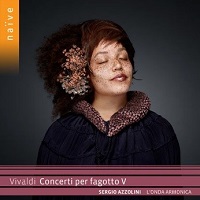 Antonio VIVALDI
Antonio VIVALDI
Concerti for Bassoon V
Concerto in a minor, RV497 [10:47]
Concerto in C, RV476 [10:24]
Concerto in F, RV486 [9:58]
Concerto in d minor, RV481 [12:10]
Concerto in C, RV467 [12:13]
Concerto in F, RV489 [11:10]
Concerto in C, RV479 [10:50]
L’Onda Armonica/Sergio Azzolini (bassoon)
Reviewed as streamed in 24/88.2 sound
rec. August 2018, Santuario di Ariadello, Soresina, Italy. DDD.
NAÏVE OP30573
[77:30] ‘This is very special music-making, a disc to relish like a dish of
glorious Venetian Risotto al nero.’ See
review
and purchase details by Gwyn Parry-Jones.
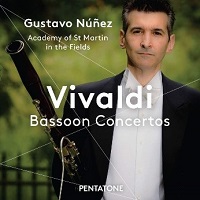 Bassoon Concerto in C, RV474 [9:26]
Bassoon Concerto in C, RV474 [9:26]
Bassoon Concerto in F, RV488 [8:17]
Bassoon Concerto in B-flat, RV501 (La Notte) [9:14]
Bassoon Concerto in C, RV477 [11:51]
Bassoon Concerto in a minor, RV497 [9:41]
Bassoon Concerto in C, RV467 [10:55]
Gustavo Núñez (bassoon)
Academy of St Martin in the Fields/Tomo Keller (leader)
rec. St. Johns Smith Square, London, April 2015. DDD/DSD.
Reviewed as downloaded from press access.
PENTATONE PTC5186539 SACD
[59:33]
SACD from
Amazon UK
–
ArkivMusic –
Presto:
stream
Naxos Music Library
Alongside their recordings of the violin concertos, Naïve
have also been bringing, as another facet of their omni-Vivaldi series, his
concertos for other instruments as well as his vocal and operatic works. I
always think of the bassoon concertos as his buffoon concertos, a
tonic if you are feeling low, with Vivaldi making the most of the jaunty
solo instrument in the fast movements and its tender and meditative
qualities in the slow movements. Naxos did them proud some time ago, with a
series of recordings from Tamás Benkócs (bassoon), Nicolaus Esterházy
Sinfonia and Béla Drahos, well worth investigating at a lower price, but a
bit earth-bound by comparison with these two recordings. Several of them
have appeared on very fine recordings by La Serenissima and Adrian Chandler
for Avie, though not, I think, among their more recent recordings for Signum.
The Pentatone recording will be a must for those wanting
SACD or hi-res downloads, but it offers significantly less music for your
money. That apart, I’m including it because we seem not to have reviewed it
when it appeared in 2016. It’s especially well worth considering for the
quality of the playing and recording – stereo only, in my case, with no
surround equipment – and the inclusion of one of Vivaldi’s remarkable concertos
which depict nightmarish visions, eventual sleep, and the arrival of the
dawn (La Notte).
Peter Whelan recorded La Notte with La Serenissima and Adrian
Chandler. They allow a little more time in each movement, but there’s not
much in it, and you may not be in the market for yet another Four Seasons, the major work on that recording (AV2344 –
review).
If you are hovering between the latest Naïve recording and the Pentatone,
the deciding factors will include the availability of the Pentatone on SACD
and as a surround download, as against the Naïve on CD or in 24/88.2 stereo
download. The Naïve offers more music and opens with one of Vivaldi’s most
oddball works, RV497. That’s included on both albums; in direct comparison
the period-instrument playing is a little more vigorous and makes the music
sound even more unconventional. On the other hand, those who prefer
playing without quite so much emphasis will go for the Academy of St
Martins (ASMF) on Pentatone. It’s not a matter of tempo: ASMF are slightly
faster than L’Onda Armonica, especially in the opening allegro molto.
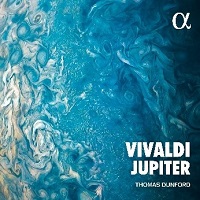 Antonio VIVALDI
Antonio VIVALDI
Gelido in ogni vena
(from Farnace, RV711) [10:49]
Armatæ face et anguibus
(from Juditha triumphans, RV644) [3:15]
Bassoon Concerto in g minor, RV495 [9:38]
Nisi dominus, RV608: Cum dederit [4:35]
Veni, veni me sequere fida
(from Juditha triumphans, RV644) [5:43]
Cello Concerto in g minor, RV416 [9:59]
Vedrò con mio diletto
(from Giustino, RV717) [6:03]
Lute Concerto in D, RV93 [9:44]
Mentre dormi, Amor fomenti
(from L’Olimpiade, RV725) [7:12]
Agitata da due venti
(from Griselda, RV718) [5:23]
JUPITER: We Are the Ocean [4:31]
Lea Desandre (mezzo), Peter Whelan (bassoon), Bruno Philippe (cello)
Jupiter/Thomas Dunford (lute)
rec. November 2018, Théâtre d’Arras, France. DDD.
Texts and translations included.
Reviewed as downloaded from press access.
ALPHA 550
[72:31] CD from
Amazon UK
–
ArkivMusic –
Presto:
stream
Naxos Music Library
If a whole album of bassoonery seems too much in one go, the concerto in g,
K495 appears on this Alpha recording of vocal and instrumental Vivaldi. I
mentioned it in another context, where I referred to the singing as too
squally for my taste, but never got around to a full review. I predicted
that others would be happier than me, and that proved to be the case, but I
still find that Lea Desandre tries a little too hard to be dramatic in the
vocal items which form the backbone of this recording. If she and the
accompaniment are rather too forceful even for me, those who remain sceptical of
the modern hipp movement really had better stay well clear. If in doubt,
those with access to Naxos Music Library can try it out there.
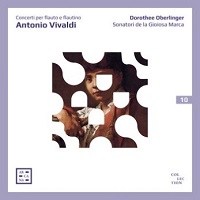 Antonio VIVALDI
Antonio VIVALDI
Concerti per flauto e flautino
Concerto in D, RV95 ‘La Pastorella’ [9:10]
Concerto in G major, RV101 [8:18]
Concerto in a minor, RV108 [7:13]
Piccolo Concerto in C, RV444 [8:59]
Concerto in G, RV443 [9:51]
Concerto in F RV442 [9:26]
Concerto for strings in B-Flat ‘Conca’, RV163 [5:54]
Dorothee Oberlinger (recorders)
Sonatori de la Gioiosa Marca
rec. 23-26 September 2004, Church of San Vigilio, Col San Martino, Treviso,
Italy. DDD.
A=440Hz
Reviewed as downloaded from press preview.
ARCANA A910
[58:59] CD from
Amazon UK
–
ArkivMusic –
Presto:
stream
Naxos Music Library
This is one of the releases in the latest Arcana Collection series. As well
as this and the Telemann music for viola da gamba (below), the collection contains:
- A901: Beethoven
Harmoniemusik (Wind band music)
Zefiro/Alfredo Bernardini
- A902: Biber: Sonaten über die Mysterien des Rosenkranzes (Mystery Sonatas)
Ars Antiqua Austria, Gunar Letzbor (violin)
- A903: Caldara: Sonate à violoncello solo col basso continuo
Gaetano Nasillo (cello), Luca Guglielmi (harpsichord), Sara Bennici (cello)
- A904: Merulo: Toccate, ricercari, canzoni d’intavolatura d’organo
Fabio Bonizzoni (early keyboard instruments)
- A905: Paladin: Tablature de Luth
Eugène Ferré (lute)
- A906:
Davide Perez: Mattutino de’ Morti (Mattins of the Dead)
Roberta Invernizzi, Salvo Vitale, Coro e Orchestra Ghislieri, Giulio Prandi
- A907: Schubert: String Quartets D46 & ‘Rosamunde’ D 804
Festetics Quartet
- A908: Tartini: Suonate a violino e violoncello o cimbalo
Enrico Gatti, Gaetano Nasillo, Guido Morini
Though these sell at mid-price on CD, I’m surprised to find the dealers that I
checked asking the equivalent of full price for the lossless downloads,
with even mp3 costing more than the physical product. The least expensive
that I could find was uk7digital.com, at £10.49, without booklet. On the
other hand, the Vivaldi and Telemann, among others in the series, were well
worth full price, so they represent real bargains in their new CD format.
Though there are several recordings of these Vivaldi concertos, Dorothee
Oberlinger, virtuosic on five different recorders, and Sonatori de la
Gioiosa Marca sound consistently among the most imaginative, the brightest
and liveliest, living up to the gioiosa part of their title.
There’s no sense of rushing the music, however: RV163 is given more space
than by Onofri on the Concerti Particolari recording (above) or by
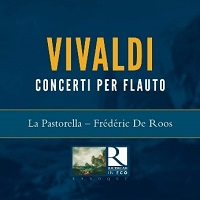 Adrian Chandler and La Serenissima (Avie AV2201 –
review,
or, for a much more favourable view of La Conca and the rest of
the programme,
December 2010). That’s partly due to the additional solo flautino part in the andante second movement. The higher ‘Venetian’ tuning contributes
to the attraction of the Arcana reissue.
Adrian Chandler and La Serenissima (Avie AV2201 –
review,
or, for a much more favourable view of La Conca and the rest of
the programme,
December 2010). That’s partly due to the additional solo flautino part in the andante second movement. The higher ‘Venetian’ tuning contributes
to the attraction of the Arcana reissue.
If, as I expect, you fall in love with this recording and wish to explore
further, another recent reissue from the Outhere group of labels could be
what you are looking for: Ricercar RIC130, a 2-CD release,
contains the six Op.10 flute concertos and a selection of chamber concertos
with flute, RV99, 106, 217, 105, 87, 103 and 88, performed by Frédéric De
Roos (flute) and La Pastorella. This time, not only do the CDs sell as two
for the price of one, for around £7.50, the lossless download can be found
for less than £4, complete with booklet. (See
Reissues January 2018
for that and a full-price recording on Alpha 281.)
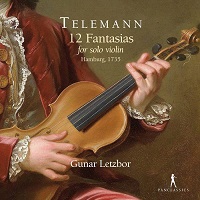 Georg Philipp TELEMANN (1681-1767)
Georg Philipp TELEMANN (1681-1767)
Fantasie per il Violino senza Basso
, TWV40/14-25
(12 Fantasias for solo violin, Hamburg, 1735)
Gunar Letzbor (violin, Sebastian Klotz, 18th c.)
rec. 23–25 September 2020, Augustinerzimmer, Stift St. Florian, Austria.
DDD.
PAN CLASSICS PC10429
[72:21]
CD from
Amazon UK
–
ArkivMusic –
Presto: stream
Naxos Music Library
There are several recordings of these solo violin fantasias, including
distinguished sets of performances from Fabio Biondi (Glossa GCD923406) and
Rachel Podger (Channel Classics CCS18298, download only), plus a
budget-price CD and download from Federico Guglielmo (Brilliant Classics
94616). I
reviewed
a recording of a selection of Telemann's Duos and Fantasias without bass on Arcana
some time ago, an album which includes Nos. 3 and 7 of these solo violin
works. I warned readers then not to expect too much from these solo pieces
by comparison with his concertos and cantatas, though the music is very
enjoyable when you are in the right mood – I suggested just before going to
bed, which was not meant to be a back-handed compliment.
In fact, listening to this new recording, on which Gunar Letzbor makes the
most of the oddities of these unconventional solo pieces, reminding us that
the term fantasia implies a clear departure from the baroque norm
established by Corelli, I’m not sure that the bed-time advice holds;
these are performances more for broad daylight. There’s a good
deal in the booklet about Letzbor’s style, as he himself views it, which
I’m not sure helps the reader to understand the music, but he makes the
music sound more unsettling than I recall from any other performer. So, not
the most immediately alluring of these recordings, more challenging than
easy listening, but certainly illuminating a less well-known side of
Telemann than his sacred music and larger-scale instrumental works.
The booklet would have you believe that Fantasia V comes between IX and XI
– it is, of course, No.10 – a confusion of Vs and Xs.
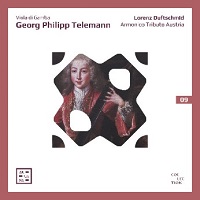 Georg Philipp TELEMANN
Georg Philipp TELEMANN
Viola di Gamba Concertos and Sonatas
Concerto in a minor for recorder, viola da gamba, strings and continuo,
TWV52:a1 [14:10]
Sonata in e minor, TWV41:e5 [8:41]
Sonata Prima in A, TWV43:A1 [11:57]
Sonata in a minor, TWV41:a6 [11:56]
Sonata in D, TWV 40:1 [12:40]
Concerto in g minor for oboe, violin, viola da gamba and continuo, TWV43:g2
[9:29]
Lorenz Duftschmid (viola da gamba)
Armonico Tributo Austria
rec. 21-26 May 1996, Evangelische Stadtkirche, Vienna. DDD.
Reviewed as downloaded from press preview
ARCANA A909
[69:08] CD from
Amazon UK
–
ArkivMusic –
Presto: stream
Naxos Music Library
Like the Vivaldi recording, this is one of the mid-price releases in
the Arcana Collection series: mid-price on CD, that is, but the dealers that I
checked are asking full price equivalent for the lossless download. The
viola da gamba may have been an old-fashioned instrument by Telemann’s
time, but he explored the possibilities of a large variety of instruments
throughout his career – these works come from various periods – and always
managed to get the best out of them. He had a particular penchant for the
more emotive d’amore versions of solo instruments, such as the
viola d’amore, and the tone of the gamba would fit into that category.
Lovers of Telemann should regard this recording not as an oddity but as an
opportunity to get to know some very attractive music, well performed and
recorded. Lorenz Duftschmid is the star of the show, but he is very well
supported by a variety of members of Armonico Tributo.
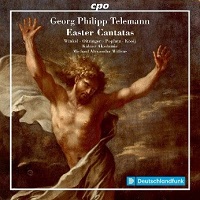 Georg Philipp TELEMANN
Georg Philipp TELEMANN
Easter Cantatas
Ich war tot, und siehe, ich bin lebendig
TWV1:872 (Easter Sunday) [13:25]
Triumph! Ihr Frommen freuet euch
TVWV1:1424 (Easter Sunday) [19:48]
Er ist auferstanden
TVWV1:460 (Easter Monday) [8:31]
Brannte nicht unser Herz in uns
TWV1:131 (Easter Monday) [14:45]
Verlass doch einst, o Mensch
TVWV1:1470 (Easter Tuesday) [14:33]
Johanna Winkel (soprano), Margot Oitzinger (alto), Georg Poplutz (tenor),
Peter Kooij (bass)
Die Kölner Akademie/Michael Alexander Willens
rec. 17-20 November 2020, Immanuelskirche, Wuppertal. DDD.
Texts and translations included.
Reviewed from download of press preview and CD.
CPO 555425-2
[71:40] CD from
Amazon UK
–
Presto
The Lutheran Hauptgottesdienst, the main Sunday service of
Telemann’s and Bach’s time, four hours long, with Matins, Litany, hour-long
sermon and Mass, may have been a thing to endure, but with cantatas of this
quality – and Bach’s, of course – well worth enduring if the performers
were anything like as good as those on this recording. And, with Lent
largely given over to Passion music or more serious music such as Gedenke doch on the CPO recording below, these joyful cantatas
must have really lifted the spirits, not just on Easter Sunday, but on
Monday and Tuesday, too, which had their own readings, as in the English
Prayer Book.
With so many recordings now available as downloads only, it’s surprising to
find the boot on the other foot this time: this recording of Easter
Cantatas appears to be available only on CD, with no download equivalent.
That means that there is nothing better than CD-quality, so hi-res
downloaders will be disappointed. It also means that if you rip CDs to your
hard drive, there’s no source for you to obtain and save the booklet.
Considering that this team has given us some excellent recordings of
Telemann, and that these appear to be the only generally available
recordings of these cantatas, I might just as well tell you to go ahead and
enjoy this latest offering. In November 2020 I sang the praises of the
team's
third volume of Telemann’s Christmas Concertos –
review. Johan van Veen was even more impressed, awarding Recommended status –
review. If you bought that, you will surely want this new recording.
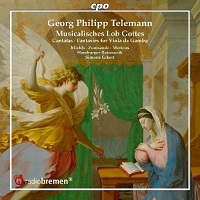 Georg Philipp TELEMANN
Georg Philipp TELEMANN
Cantatas and Fantasias
Jauchzet, ihr Himmel, Cantata (Lætare Sunday, 4th Sunday in Lent) TVWV1:957, No.23,
from Musicalisches Lob Gottes (1742-44) (18:27)
Fantasia for Viola da Gamba in c minor, TWV40:26] [4:45]
Fantasia for Viola da Gamba in D, TWV40:27 [8:09]
Gedenke doch, wie ich so elend und verlassen
(Remeniscere Sunday, 2nd Sunday in Lent), Cantata TVWV1:583 No.21,
from Musicalisches Lob Gottes [18:28]
Fantasia for Viola da Gamba in e minor, TWV40:28 [4:41]
Fantasia for Viola da Gamba in F, TWV40:29 [6:03]
Dies ist der Tag, den der Herr macht, Cantata (Feast of the Anunciation) TVWV1:359 No.24, from Musicalisches Lob Gottes [18:49]
Dorothee Mields (soprano)
Hanna Zumsande (soprano)
Klaus Mertens (bass)
Hamburger Ratsmusik/Simone Eckert (viola da gamba)
rec. ? Released May 2021.
Texts and translations included
Reviewed from download of press preview
CPO 555387–2
[79:40] CD from
Amazon UK
–
Presto
Another CD-only release; my press files came without the rear cover, where
CPO give the recording date and place, but I assume that this was set down
recently – the performers are wearing masks in the photo.
CPO’s Telemann recordings, like Naïve’s Vivaldi, are by no means a
one-ensemble affair. A year ago, Eckert and his team gave us fine performances
of Telemann’s six Moralische Kantaten (555141-2). Johan van Veen’s
only demurral from his approval of that important addition to the growing
Telemann discography was to prefer the twelve gamba fantasias in one place
–
review. We have CPO to thank for much of
the expansion of Telemann recordings: they are often in the
forefront of bringing us music not otherwise available, like the three
cantatas here from Telemann’s annual cycle Musicalisches Lob Gottes in der Gemeine des Herrn.
Two of these cantatas are for Sundays in Lent. Gedenke doch is
thoughtful in tone, but Jauchzet, ihr Himmel, for mid-Lent Sunday,
lightens the tone: traditionally, this was a time for a brief respite from
the rigours of the Lenten fast, so often known as ‘Refreshment Sunday’. The
tradition of young women working away from home returning home to their
‘mother’ church on this day has led to the modern misnomer ‘Mother’s Day’.
The third cantata celebrates the joyful message of the angel to Mary at the
Annunciation. I don’t know of any other recordings of these cantatas – they
may even be unclaimed premiere recordings – but you are hardly likely ever
to come across better performances. Telemann’s many lovers will want both
these CPO recordings. While both sound very fine in the CD-quality wav
files which I received for review, it’s unfortunate that hi-res fans don’t
have access to 24-bit.
As on the earlier Eckert recording, three of the gamba fantasias are interspersed
among the cantatas, so I presume that CPO intend to build up to a complete
set of the twelve across a number of cantata recordings. In performances
this good, they deserve to be better known; as on the reissued Arcana
recording of gamba concertos and sonatas (above), it’s remarkable that
Telemann was able to write such remarkable music for an instrument
generally regarded as obsolete in his time. If, as Johan van Veen suggests,
you may prefer all these fantasias in one place, Glossa can oblige with
recordings by Paolo Pandolfo (GCD920417: Recording of the Month –
review), as can Richard Boothby on Signum –
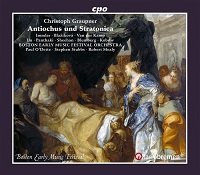 review. At the risk of upsetting some readers, I prefer Telemann’s gamba music to
that of Marin Marais, which was made famous some years ago by the film Tous les Matins du Monde.
review. At the risk of upsetting some readers, I prefer Telemann’s gamba music to
that of Marin Marais, which was made famous some years ago by the film Tous les Matins du Monde.
CPO have done much to make Telemann’s music available – and that of many of his contemporaries. Which reminds me that their 2020 recording of
Graupner’s
Antiochus und Stratonica has been in my in-tray for far too long. For the moment, I’ll just mention that
very fine 3-CD set with a starry cast of baroque specialists (Christian Immler, Hana Blažicková, Harry van der Kamp, Sunhae Im, and others) with the Boston Early Music Festival Orchestra, jointly directed by Paul O’Dette and Stephen Stubbs (CPO 555369-2).
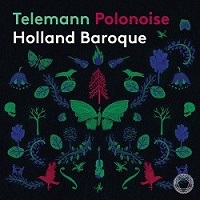 Telemann Polonoise
Telemann Polonoise
Polish-inspired music in arrangements by Judith and Tineke Steenbrink
Aisslinn Nosky (violin)
Holland Baroque
rec. Musis, Arnhem, The Netherlands, August 2020. DDD/DSD
Reviewed as downloaded from press access
PENTATONE PTC5186878 SACD
[67:50] Please see my separate
review and
review by Johan van Veen.
Overall, this new Pentatone selection of Polish-inspired music is a fine
and enjoyable addition to the available recordings of Telemann. Though
there are now many such albums that are well worth your consideration, they
still only scratch the surface of this prolific composer’s music, so the
more recordings of this quality the better.
A colleague has recently reminded me of the rich back catalogue available
on the Hungarian label Hungaroton. I am trying to obtain access to their
recordings as downloads, and I have reviewed some of their recordings in
the past, but, just as an appetite-whetter, you might try an album of three
TELEMANN Overture-Suites:
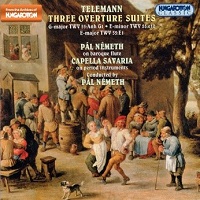 Overture Suite in G, TWV55:Anh.G1 ‘La Putain’ [19:58]
Overture Suite in G, TWV55:Anh.G1 ‘La Putain’ [19:58]
Overture (Suite) in e minor, TWV55:e10 [19:37]
Overture (Suite) TWV55:E1 in E for strings & b.c. [17:56]
Capella Savaria/Pál Németh (baroque flute)
On period instruments. Download only.
© 2014?
Reviewed as streamed.
HUNGAROTON HCD31741
[57:31]
Download mp3 and lossless from
Presto: stream
Naxos Music Library
Mostly very lively music, especially the opening ‘La Putain’ (the whore),
in bright and lively performances on period instruments. Some of this
ensemble’s recordings have been a little less than polished, but there’s
nothing really amiss here, and the recording is good. There’s no CD
available, and there are no notes with the download or streamed versions.
Capella Savaria also made a fine recording, with Nicholas McGegan in
charge, of Vivaldi Concertos and Sinfonias:
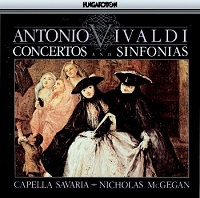
Concertos for strings in C, RV117, in g minor, RV157, in G, RV146, in
B-flat ‘Conca’, in c minor, RV119 and in C, RV114;
Sinfonias for strings in G, RV146, and in b minor ‘Al Santo Sepolcro’,
RV169,
Sonata for 2 violins and viola in E-flat ‘Al Santo Sepolcro’, RV130
rec. 1986?
HUNGAROTON HCD12547 [44:43]
Download mp3 and lossless from
Presto: stream
Naxos Music Library
Inevitable overlaps apart, including
some with the newer recordings listed above, this download- or
streaming-only recording is well worth considering.
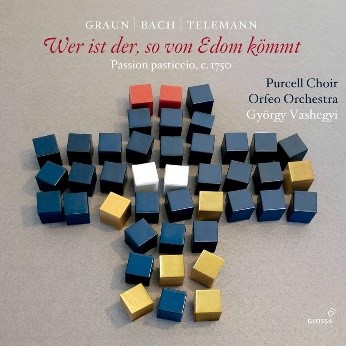 I seem not to be alone in rather belatedly noting a Glossa release timed
for Holy Week 2021. Entitled Passion pasticcio ca. 1750: Wer ist der, so von Edom kömmt, it’s a pastiche of music for that week spliced together from works by
Carl Heinrich
GRAUN (1704-1759), Georg Philipp TELEMANN (1681-1767)
and Johann Sebastian BACH (1685-1750). It’s performed by
Ágnes Kovács (soprano), Péter Bárány (countertenor), Zoltán Megyesi (tenor)
and Lóránt Najbauer (bass), the Purcell Choir, the early music ensemble
Orfeo Orchestra and György Vashegyi (GCD924011 [46:05 +
67:57]). Texts and translations are included.
I seem not to be alone in rather belatedly noting a Glossa release timed
for Holy Week 2021. Entitled Passion pasticcio ca. 1750: Wer ist der, so von Edom kömmt, it’s a pastiche of music for that week spliced together from works by
Carl Heinrich
GRAUN (1704-1759), Georg Philipp TELEMANN (1681-1767)
and Johann Sebastian BACH (1685-1750). It’s performed by
Ágnes Kovács (soprano), Péter Bárány (countertenor), Zoltán Megyesi (tenor)
and Lóránt Najbauer (bass), the Purcell Choir, the early music ensemble
Orfeo Orchestra and György Vashegyi (GCD924011 [46:05 +
67:57]). Texts and translations are included.
Like the multi-coloured blocks on the cover, the music, from three
composers and various sources, meshes quite well together. The title is
taken from the Telemann contribution, TWV1:1585, a setting of words from
Isaiah, one of the
Mass readings for Holy Week – who is this that cometh from Edom? – and it’s
interwoven with Graun’s Passion oratorio on the sacrifice of Christ as the
Passover Lamb, Ein Lämmlein geht und trägt die Schuld, GraunWV B:VII:4, and
excerpts from Bach.
Whatever your view of such hybrids – and the process is not very different
from what Bach and Handel did in ‘borrowing’ from themselves and others –
you are unlikely to obtain the Graun Passion oratorio in any purer form.
And don’t forget that, as the notes in the booklet remind us, any
performance of Bach’s St John Passion – to which one could add
Handel’s Messiah – is a pastiche, because the work does not exist
in one definitive form. Some of the singing is not ideal, but the
performance and recording generally make a good case for the music of a
composer still under the shadow of Bach and Telemann.
***
Finally, I can’t resist breaking my self-imposed rule again with an album
that I had passed over until I heard some of it on BBC Radio 3. The very
nondescript cover may have been part of the reason for missing it – another reminder that
there’s no art to find the mind’s construction in the face, or don’t judge
a book by its cover. The music is by, or arranged by the three performers,
but the central works are based on works by Hildegard of Bingen and
Pérotin, together with anonymous pieces from three important late medieval,
early modern anthologies:
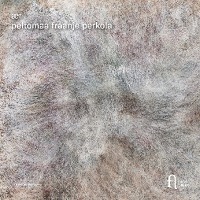 Unum
[4:11]
Unum
[4:11]
HILDEGARD von Bingen (1098-1179)
O Virtus Sapientie
[2:26]
PÉROTIN (1160-1230)
Beata Viscera
[9:49]
Codex Las Huelgas
(14th century)
Quis Dabit
[5:31]
Piæ Cantiones
(16th century)
Sum in Aliena
[3:25]
Rain 1 [1:16]
Llibre Vermell de Montserrat
(14th century)
Polorum Regina
[5:56]
ÆR
[5:27]
Via
[3:25]
Aino Peltomaa (voice, medieval harp, bells)
Harmen Fraanje (grand piano, prepared upright piano)
Mikko Perkola (viola da gamba, voice, effects & electronics)
rec. 13 & 14 November 2019, St. Lawrence Chapel, Vantaa, Finland. DDD.
Reviewed as downloaded from press preview.
FUGA LIBERA FUG770
[51:10] CD from
Amazon UK
–
ArkivMusic –
Presto: stream
Naxos Music Library
The title ÆR, is derived the title track, inspired by a quotation
from Hildegard of Bingen, given in the booklet:
Aer enim volat / et cum omnibus creaturis officia sua exercet / et
firmamentum eum sustinet / ac aer in viribus istius pascitur.
[The air flows and exercises its functions for all creatures; the firmament
sustains it, while the air is nourished by its power.] By ær, I
imagine that Hildegard was thinking also of the wind of the spirit: both
Hebrew ruach and Greek pneuma mean equally wind and spirit.
Unhelpfully, no translation is offered; indeed, the only text offered is that of Hildegard’s O virtus Sapientie, and that is
paraphrased rather than translated. I’m not sure if the other works are
sung wordlessly; if not, I can’t make the words out, though the odd muffled
word of the Marian hymn Polorum Regina seems to break through.
More importantly, the spirit of the piece is maintained.
Many will think this an irredeemable mess; it’s certainly not authentic –
more Adiemus than medieval – and so it is, in many respects. Yet I
found it interesting and, in some cases, such as Polorum Regina,
almost irresistible. This is my first encounter with the Trio Peltomaa
Fraanje Perkola – as far as I can see, there’s nothing else by them in the
catalogue – but I think it won’t be the last.
If Polorum Regina inspires you to track down the original setting
from the Llibre Vermell, the Red Book from Montserrat, it’s included in a
fine selection from Jordi Savall with La Capella Reial de Catalunya and
Hespérion XXI (AVSA9919, SACD and DVD video: Recording of the Month –
review). There’s an earlier Savall recording (Erato 6286582, mid-price –
review, download only from some dealers), and a shorter version on a recording of
another selection from the book by the New London Consort and Philip Pickett (Decca
L’Oiseau Lyre 4331862, download only, no booklet). The Erato Savall is
offered as a lossless download by one dealer for £6.26 and £15.69, and by
another for £16.99. There’s no booklet with any of them, but you know which
to choose.
Very puzzlingly, one website offering a download of the Llibre Vermell
lists several tracks, including Polorum Regina, as ‘explicit’. The
ever-virgin queen of the heavens explicit?
I said no Bach, but, just as I was finalising converting this to a web page, Beulah (eavb.co.uk) announced the release in July
2021 of The Essence of J S Bach, one of their valuable
download-only trips down memory lane on 1PS97:
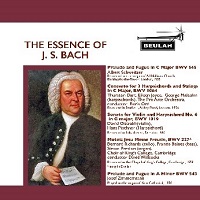 - Prelude and Fugue in C, BWV545 – Albert Schweitzer, organ of All Hallows
Church, Barking-by-the Tower, rec. 1935
- Prelude and Fugue in C, BWV545 – Albert Schweitzer, organ of All Hallows
Church, Barking-by-the Tower, rec. 1935
- Concerto for 3 harpsichords and strings, BWV1064 – Thurston Dart, Eileen
Joyce, George Malcolm (harpsichords), Pro Arte Orchestra/Boris Ord, rec.
Studio 1, Abbey Road, 1956
- Sonata for violin and harpsichord No.6, BWV1019 – David Oistrakh
(violin), Hans Pischner (harpsichord), rec. Lukaskirche, Dresden, 1960
- Motet: Jesu meine Freude, BWV227 (sung in English) – Richard
Richards (cello), Francis Baines (bass), Simon Preston (organ); Choir of
King’s College, Cambridge/David Willcocks – rec. King’s College Chapel,
1959
- Prelude and Fugue in a minor, BWV543 – Josef Zimmermann – rec. Köln
Cathedral organ, 1956
I’m planning another catch-up article on Beulah releases, so I’ll just draw
attention to this release, note that it represents styles of Bach just
prior to the historical performance revolution, of which Thurston Dart was
one of the precursors, and recommend, as usual, downloading when it’s
available from Qobuz – lossless transfers for the same price as mp3 from
other sites.
